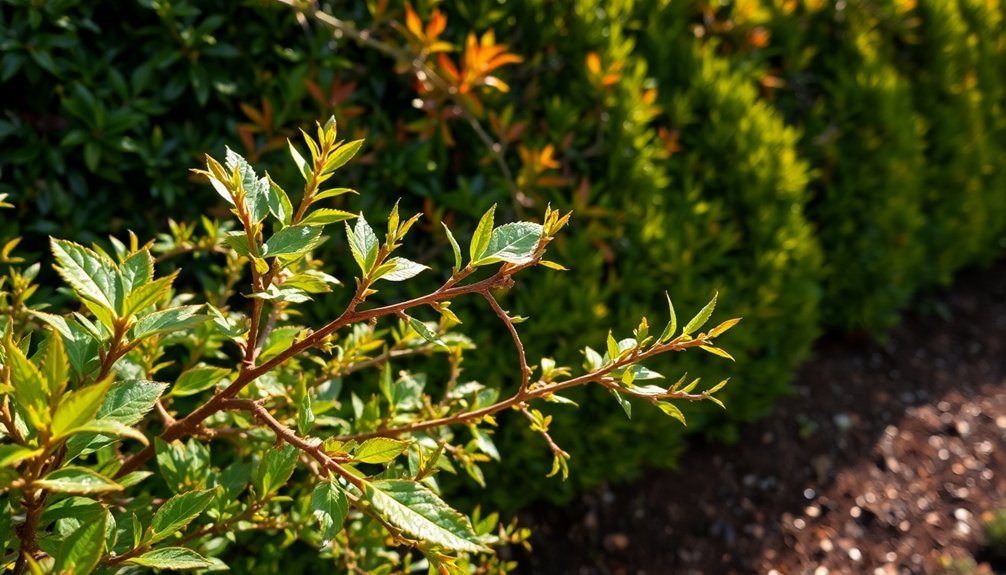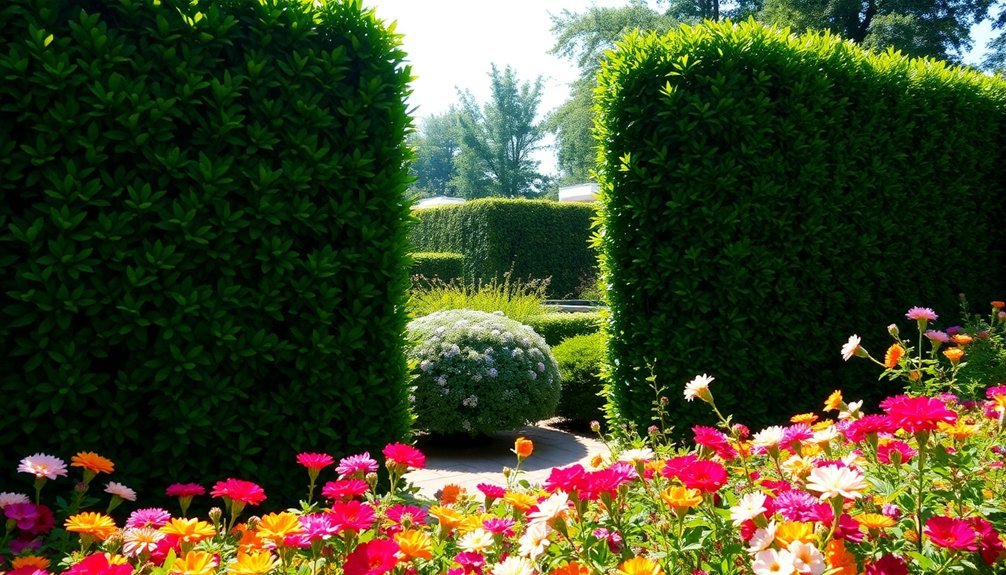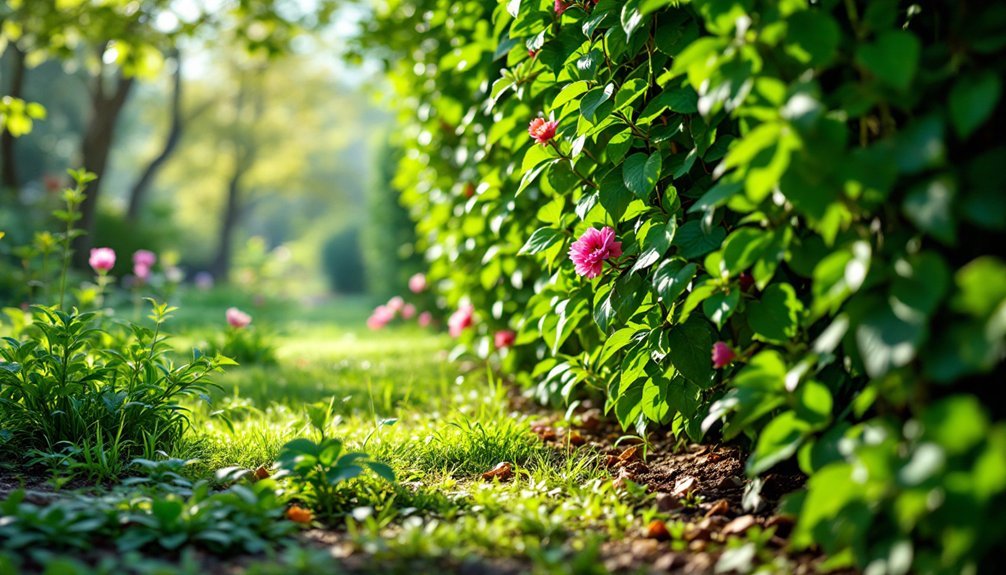Pruning living barriers according to seasons optimizes their health and performance. In winter/early spring, you'll encourage robust new growth while plants are dormant. Summer maintenance controls height and spread during active growth phases. Fall preparation strengthens barriers before winter stress, while avoiding cuts that stimulate vulnerable new growth. Timing your pruning with natural growth cycles minimizes stress and maximizes privacy, structure, and longevity. Each seasonal approach offers unique benefits for your living fence investment.
Seasonal Timing: Optimizing Your Living Barrier's Growth Cycle

While many gardeners focus solely on aesthetics, the timing of your pruning efforts dramatically affects both the health and privacy function of living barriers. Your plants respond differently to seasonal shifts in temperature, daylight, and moisture, making timing essential for maintaining density and vigor.
Prune most barriers in late winter or early spring before new growth emerges to minimize stress. This strategic timing supports natural growth cycles and prevents disease spread that flourishes in specific seasons. Regular maintenance ensures your screens maintain their environmental benefits while providing the desired privacy.
Avoid autumn pruning as it encourages frost-vulnerable new growth.
Light summer trimming helps maintain shape without stimulating tender new growth that won't harden before winter.
As climate patterns shift, you'll need to adjust your pruning schedule to accommodate changing seasonal timing and guarantee your living barrier continues providing year-round privacy.
Spring Renewal: Shaping Hedges for Maximum Density
Spring represents nature's perfect opportunity to revitalize your living barriers through strategic pruning. As new growth emerges, remove dead branches and reshape your hedge to maximize sunlight penetration—ensuring denser foliage throughout.
You'll achieve best results using sharp, appropriate tools: hand shears for precision work, loppers for thicker branches, or powered trimmers for larger hedges. Always cut slightly more from the top to prevent lower sections from being shaded.
Timing is essential—prune evergreens before new growth begins, but wait until after flowering for spring-blooming varieties. For newly planted hedges, limit pruning to allow proper establishment. Cloudy days in spring provide ideal pruning conditions to minimize stress and prevent excessive leaf burn.
Timing dictates success—respect your hedge's natural cycle for optimal growth and vibrant displays.
This seasonal attention promotes balanced growth, enhances aesthetic appeal, and creates wildlife-friendly barriers while reducing your long-term maintenance needs.
Summer Maintenance: Controlling Height and Spread

As summer temperatures rise, your living barriers enter a critical growth phase that demands vigilant maintenance. Controlling height prevents structural damage while managing spread keeps pathways clear and respects boundary lines. Proper trimming can create an effective temperature buffer that helps regulate your home's climate similar to how radiant barriers work in attics.
| Pruning Element | Benefits | Timing |
|---|---|---|
| Height control | Prevents overreach and stress | Early morning |
| Spread management | Maintains boundaries | After new growth appears |
| Tool selection | Guarantees clean cuts | Before intense heat |
Prune during cooler morning hours to reduce plant stress. Before making your first cut, take photos or sketch your barrier to plan the desired shape. You'll need different tools depending on branch thickness—shears for thin stems, loppers for thicker branches, and hedge clippers for uniform edges. Remember that summer pruning helps improve air circulation and reduces water loss during this potentially stressful season.
Fall Preparation: Strengthening Natural Fences Before Winter
Fall represents a critical turning point in your living barrier's annual cycle, when deciduous varieties begin shedding leaves and all plants prepare for dormancy. This makes it the ideal time to prune for winter readiness.
As leaves drop, you'll gain clear visibility of your fence's structure, allowing for more precise pruning decisions. Focus on making angled cuts to prevent water collection and remove dead or diseased branches that could become entry points for pests. Pruning during fall minimizes energy use for healing as plants enter their dormant period.
- Remove suckers from the base to prevent resource competition
- Use sharp tools appropriate for branch size—hand pruners for small branches, loppers for medium, and saws for larger cuts
- Avoid over-pruning, which can stress plants entering dormancy
This strategic fall pruning redirects energy to healthy growth and strengthens your living barrier against winter's challenges.
Winter Dormancy: Strategic Pruning for Next Year's Barrier Performance

Winter dormancy offers the perfect opportunity to shape your living barriers while they rest. With foliage gone, you'll easily spot damaged branches and structural issues in deciduous species like maple and oak. Your pruning efforts now will prevent disease spread since insects are inactive, and you'll improve airflow through the barrier.
Seize winter's leafless clarity to identify flaws and strengthen your living landscape investments.
Use sharp tools to make clean, slanting cuts just above buds to direct spring growth. For larger branches, implement the three-part cut technique to prevent tearing. This approach supports sustainable gardening principles by maintaining plant health naturally.
Winter pruning particularly benefits fruit trees and shrubs that bloom on new wood, like spirea and most roses.
This strategic timing not only saves you time but can increase your property value up to 14% while creating stronger barriers that require less maintenance throughout the growing season.
Frequently Asked Questions
Can Living Barriers Attract Unwanted Wildlife Despite Seasonal Pruning?
Yes, living barriers can still attract unwanted wildlife despite seasonal pruning if you don't manage them properly. Some species remain drawn to dense foliage, berries, or nesting sites regardless of your pruning schedule.
How Does Soil Composition Affect Seasonal Pruning Requirements?
Your soil's texture, fertility, and microbial activity determine when you'll need to prune. Sandy soils require less frequent pruning, while clay soils with high nutrient content support faster growth, demanding more regular maintenance throughout seasons.
Are Power Tools or Hand Pruners Better for Different Seasons?
Power tools work best in winter when plants are dormant, while hand pruners are ideal in summer for precision. You'll find bypass pruners give cleaner cuts year-round compared to other manual options.
Will Neighboring Trees Impact My Barrier's Pruning Schedule?
Yes, neighboring trees will impact your barrier's pruning schedule. They create shade, compete for resources, and may spread diseases, requiring you to adjust timing and techniques to maintain your barrier's health and appearance.
Can Pruning Timing Help Reduce Allergens From Flowering Barriers?
Yes, pruning before flowering season can markedly reduce allergens from your barriers. You'll want to trim in late winter or early spring to remove potential pollen-producing parts before they develop and release allergens.
In Summary
By pruning your living barriers according to the seasons, you'll maximize their effectiveness and longevity. You're not just cutting plants—you're working with nature's rhythms to develop stronger, denser boundaries. When you time your pruning strategically, you'll enjoy better growth in spring, controlled spread in summer, winter-ready strength in fall, and set yourself up for next year's success during dormancy. Your barrier will thank you.





Leave a Reply